Behind every movie and show you watch is an array of moving parts. Production teams consist of sometimes hundreds of crew and cast members. Each unique role helps in accomplishing the collective goal, which is to produce content for an audience.
In the entertainment industry, there are numerous written and visual documents for productions to make decisions. These documents not only structure and organize production information but also guide the cast and crew every step of the way.
None of those documents are more important than.. the screenplay. So, what is a screenplay anyway?
What Is A Screenplay?
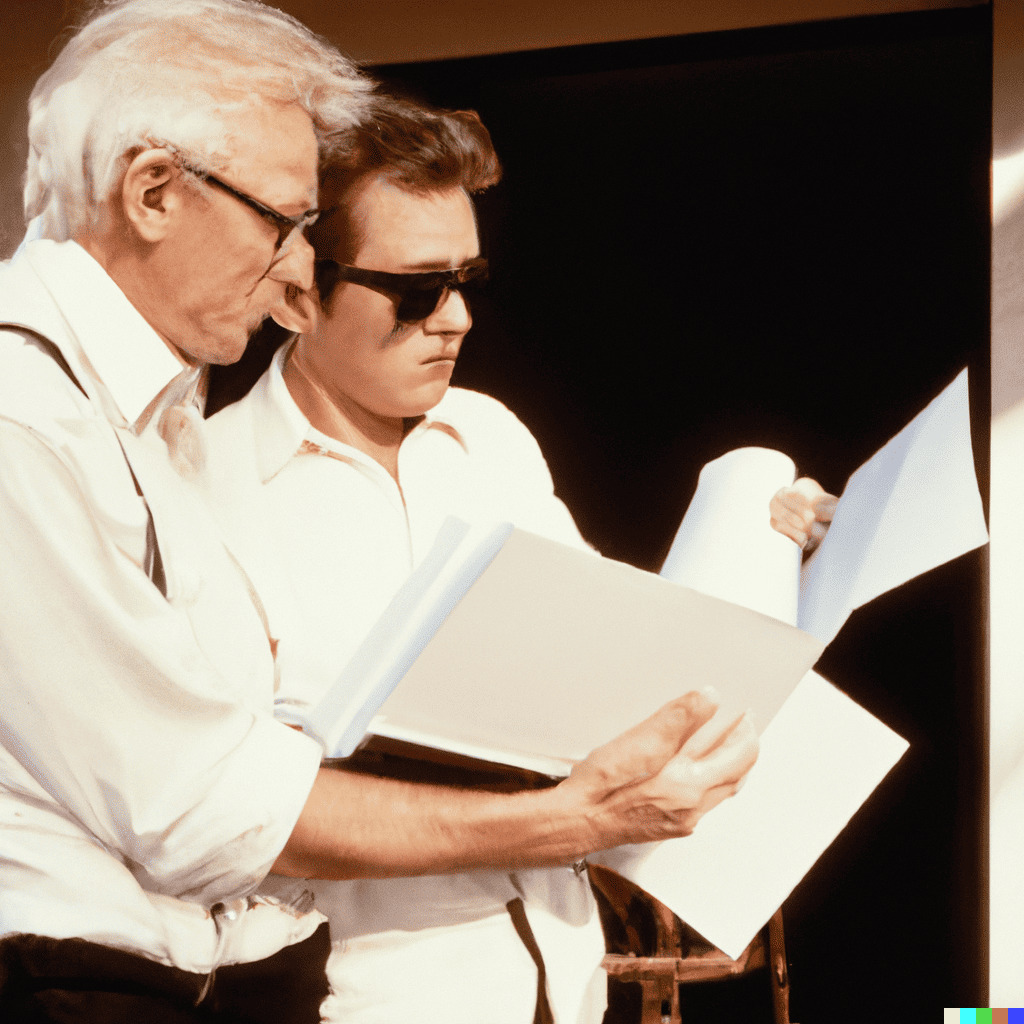
A screenplay, also known as a script, is a written work that provides the narrative structure for a film, television show, or commercial. It lays out the dialogue, character descriptions, and detailed instructions about scenes, settings, and actions.
Screenplays are written in a specific format that allows for easy understanding of the story's progression. They guide directors, actors, and other production staff in bringing the story to life on the big screen.
A screenplay details everything from major plot points and character arcs to specific actions, expressions, and lines of dialogue. It's an essential tool in the filmmaking process.
Screenplays often go through many revisions. Even during and after primary production.
Screenplays should always be in the present tense.
How Do I Structure A Story Into A Screenplay?
Writing a screenplay requires a specific structure and format. Here's a step-by-step guide on how to structure a story into a screenplay:
- Concept: Start with a clear, concise concept for your story. This should be a one-sentence summary of your film that captures the essence of your story.
- Outline: Create an outline of your story. This is a broad overview of what happens in your story from beginning to end.
- Character Development: Develop your characters. Understand their motivations, conflicts, and arcs. Your characters should drive the plot forward.
- Structure: Most screenplays follow a three-act structure. The 7 Point Story Structure is quickly gaining popularity, as well as other alternative structures.
- Scene Breakdown: Break your story down into individual scenes. Each scene should move the story forward and have a clear purpose.
- Formatting: Write your screenplay using proper screenplay formatting. Proper screenplay format includes specific guidelines for margins, spacing, how to write dialogue, etc. Screenwriting software like Final Draft and Celtx can help with this.
- Show, Don't Tell: In a screenplay, your story is told through visuals and dialogue, not narration. Show what's happening rather than telling.
- Dialogue: Use dialogue to reveal character traits and advance the plot. Make sure each character has a unique voice.
- Revision: Once you've finished your first draft, revise it. Look for areas where the story can be tightened, dialogue can be improved, or scenes can be clarified.
Every story may require a different script format. Writing scripts is a process that often involves many drafts and lots of revising.
What Is A Logline?
This is a brief (usually one-sentence) summary of a movie or TV show, often providing both a synopsis of the plot and an emotional "hook" to stimulate interest. A good logline will introduce your protagonist, their goal, and the antagonist or obstacle that stands in their way. It's primarily used in the pitching process to give a concise idea of what the story is about.
What Is A Script Treatment?
A script treatment, or simply 'treatment', is a detailed summary of a screenplay. While less formal and structured than the script itself, it serves as an essential precursor and planning tool in the screenwriting process. It bridges the gap between the initial story outline and the first draft of the screenplay.
Typically, a treatment outlines the entire plot in a narrative format, giving a clear picture of the main characters, their motivations, and the story arc. It is presented scene by scene, resembling a short story that adheres to the film's structure.
While there is no standard length for a treatment, it is usually between 5 to 20 pages long, depending on the complexity of the story.
Writing a treatment can be an invaluable tool for screenwriters to clarify their thoughts, refine the narrative, and ensure their screenplay has a strong foundation before diving into dialogue and scene specifics.
How Do Screenwriters Use Index Cards To Build A Script?

Screenwriters often use index cards as a physical tool to outline and organize their ideas, providing a tangible way to visualize the screenplay's structure. Each index card represents a scene or key event within the narrative. They write brief descriptions of what happens in each scene on the cards.
The flexibility of this method allows writers to easily move scenes around to experiment with the chronological order, identify plot holes, and highlight areas where the pacing might need adjustment. Color coding can also be employed to track different characters, themes, or plotlines. This process of arranging and rearranging the cards aids in constructing a well-paced narrative.
What Is The Three-Act Structure?
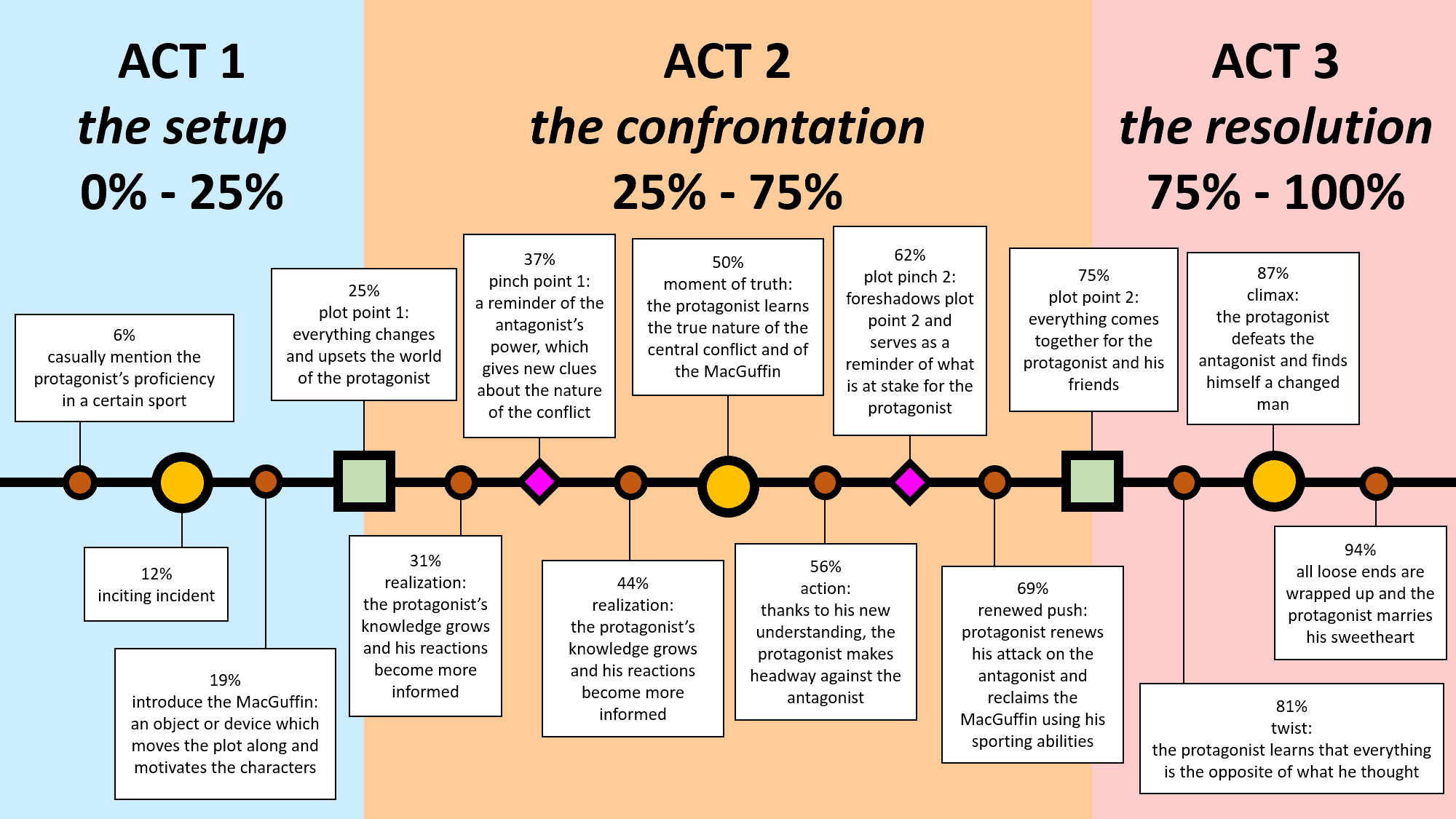
The Three-Act Structure is a model used in narrative fiction that divides the story into three parts, or 'acts', namely: the Setup, the Confrontation, and the Resolution.
Act 1 - The Setup
This act establishes the main characters, their relationships, and the world they live in. It introduces the protagonist or the central character, the antagonist or the opposing force, and the supporting characters. During this stage, an inciting incident occurs that disrupts the status quo, propelling the protagonist to take action. This incident sets the course for the rest of the story.
Act 2 - The Confrontation
Often the lengthiest part of the story, the Confrontation sees the protagonist face the main conflict head-on. It's a series of trials and tribulations that test the protagonist's resolve and abilities. The stakes are raised, and tension builds as the protagonist approaches the climax of the story.
Act 3 - The Resolution
The climax of the story happens here, where the protagonist confronts the antagonist or the main issue. The tension reaches its peak, and the conflict reaches its conclusion. This act resolves the story's main conflict and ties up loose ends, giving the audience a sense of closure.
The Three-Act Structure is the most common structure used in cinema. However, there are various other structures that you should consider. Namely, the 7-Point Story Structure.
How Should A Screenplay Be Formatted?
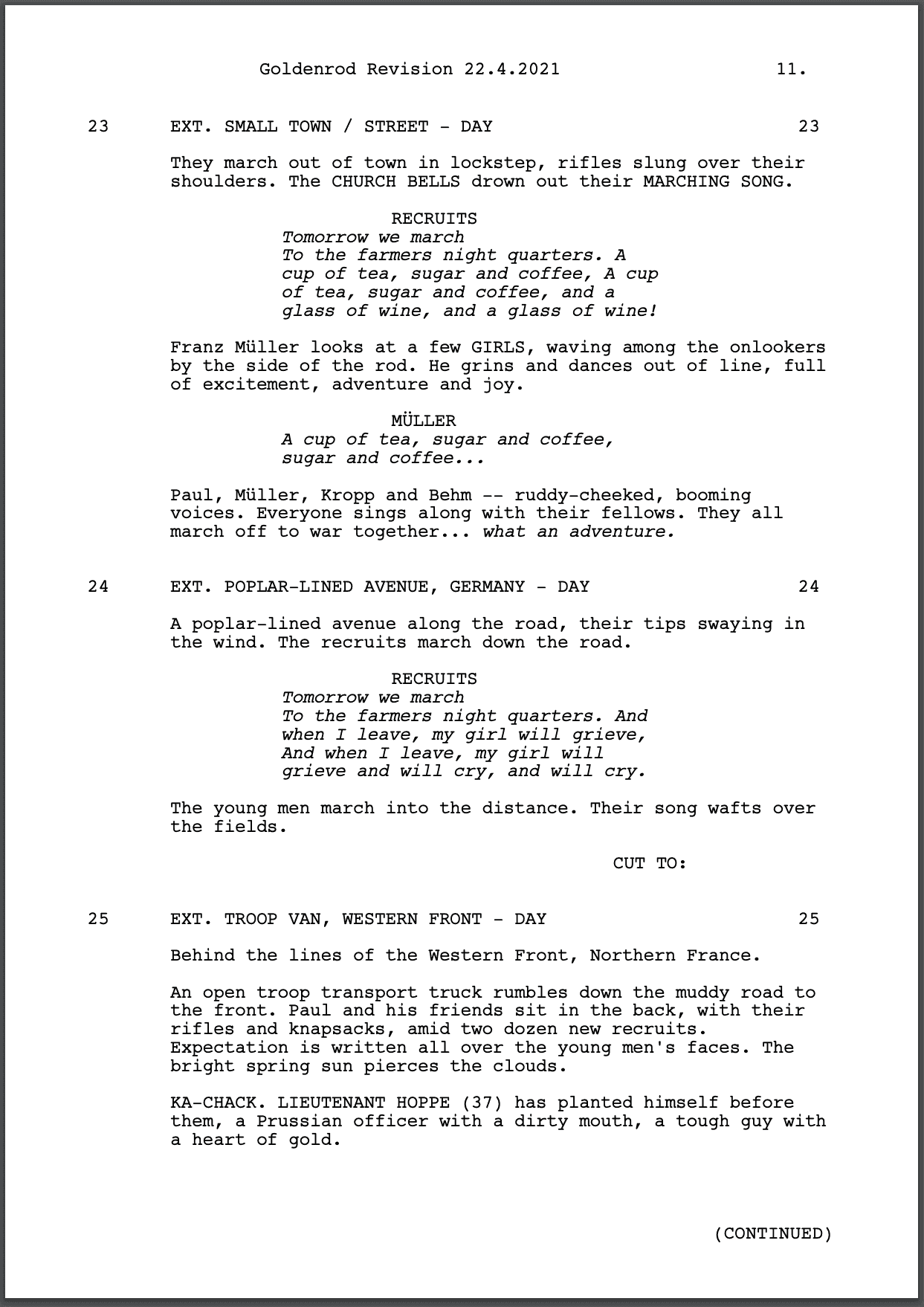
The standard screenplay format:
- Page numbers are at the top right corner
- 0.5-inch margin from the top for page numbers
- Page 1 is when the action lines and dialogue begin
- Scene numbers on the left and right of each new scene heading
- 12-point Size
- Font: Courier
- Double-spaced dialogue
- Measure from the edge of the left or top margins
- The 1.5-inch margin on the left
- 1 inch for the right, top, and bottom margins
- The 2.5-inch margin on the left for all dialogue
- The 3.7-inch margin on the left for character names
- All uppercase letters for character names, transitions, act breaks, and scene headings
What Parts Go In Front Of A Screenplay?
Several important cards must appear before you start reading the action lines and dialogue.
Title Page
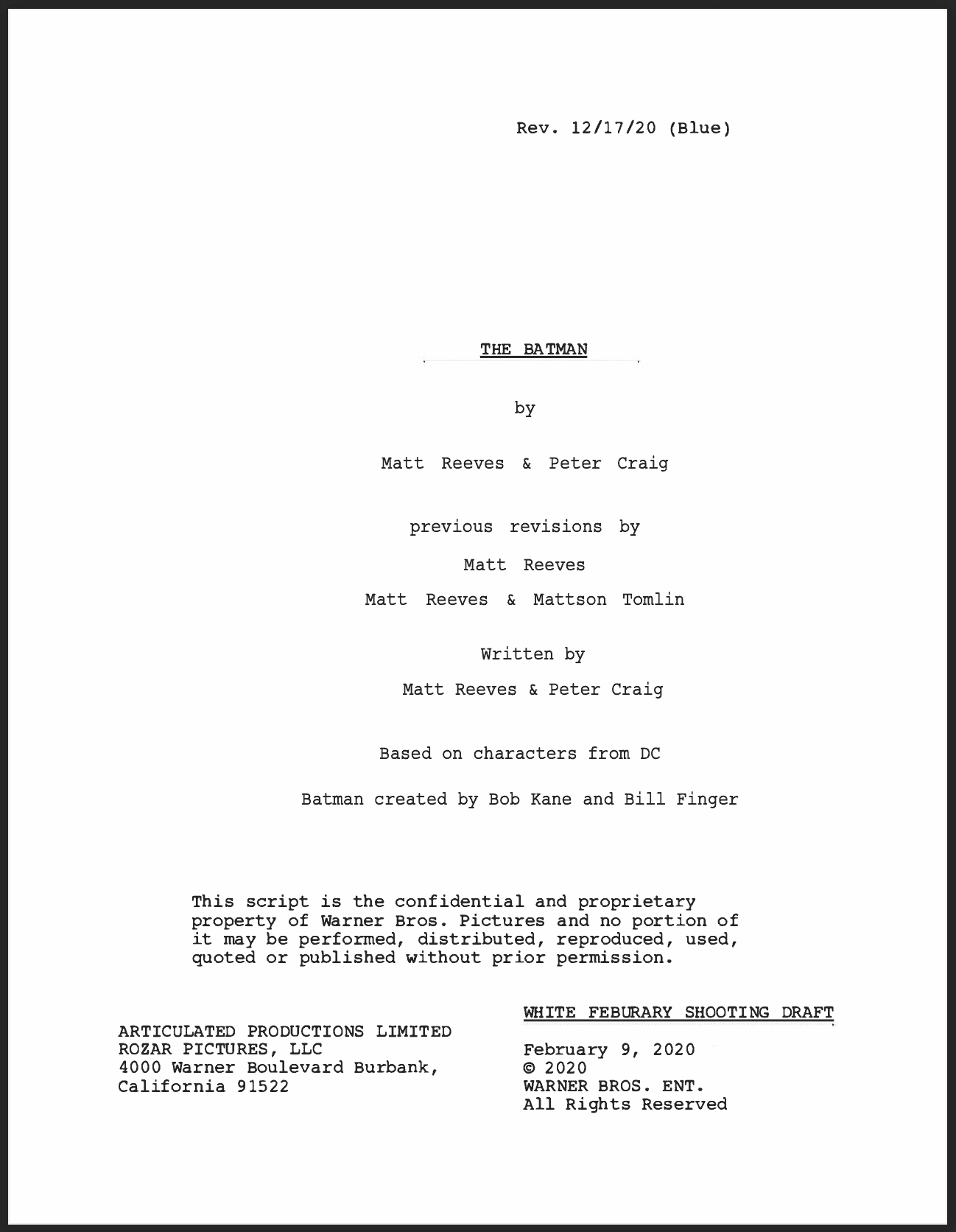
The title page of a screenplay is the first page in your script.
It should include the title, author's name, and contact information, along with other pertinent information such as a copyright or WGA registration number.
One little secret: Don't date your screenplay if you're trying to sell it. This way, it'll always appear to be a "new script".
Cast List
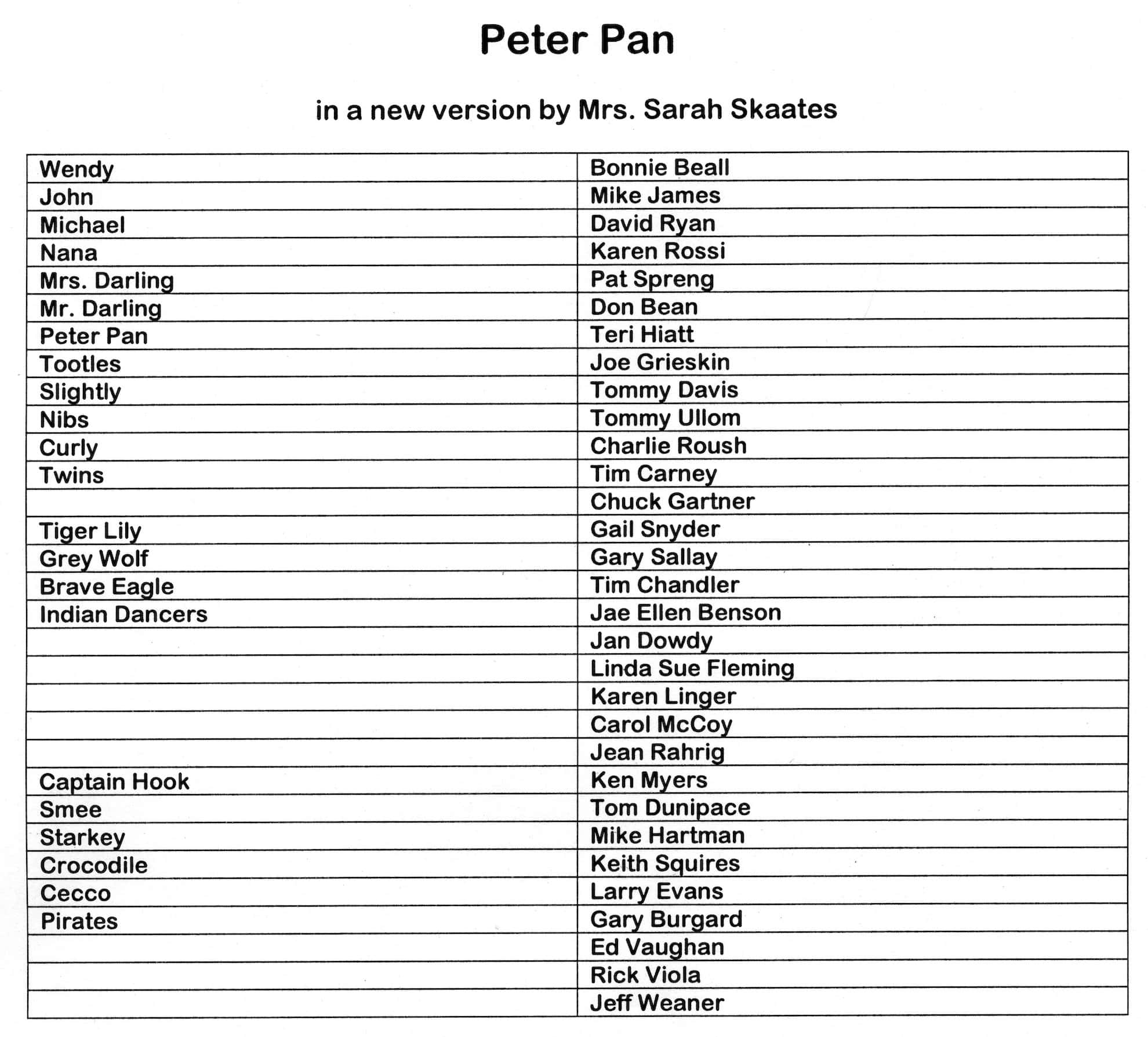
Right after the title card, there will be a cast list. This list features all the cast and their character roles. A movie cast list is much like a cast list for stage plays.
Location List
A location list will provide all the relevant locations to the screenplay. As the screenplay is constantly going through revisions, the location list will be changing constantly as well.
Shot List
Simply a breakdown of all the shots needed to create each scene.
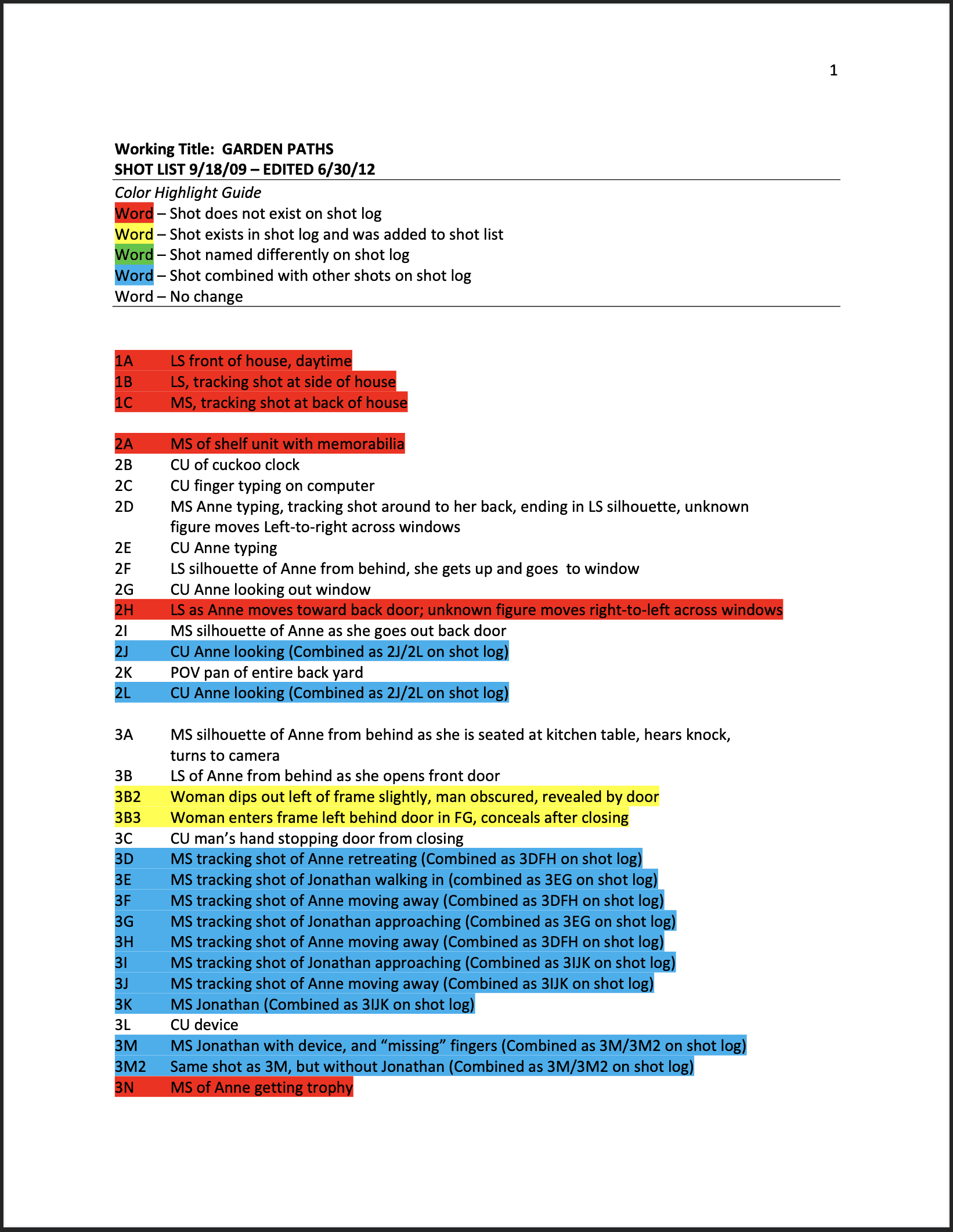
A shot list might indicate to a videographer what lens to use. Or to an actor how much room he has to move.
What Are The Main Parts Of A Screenplay?
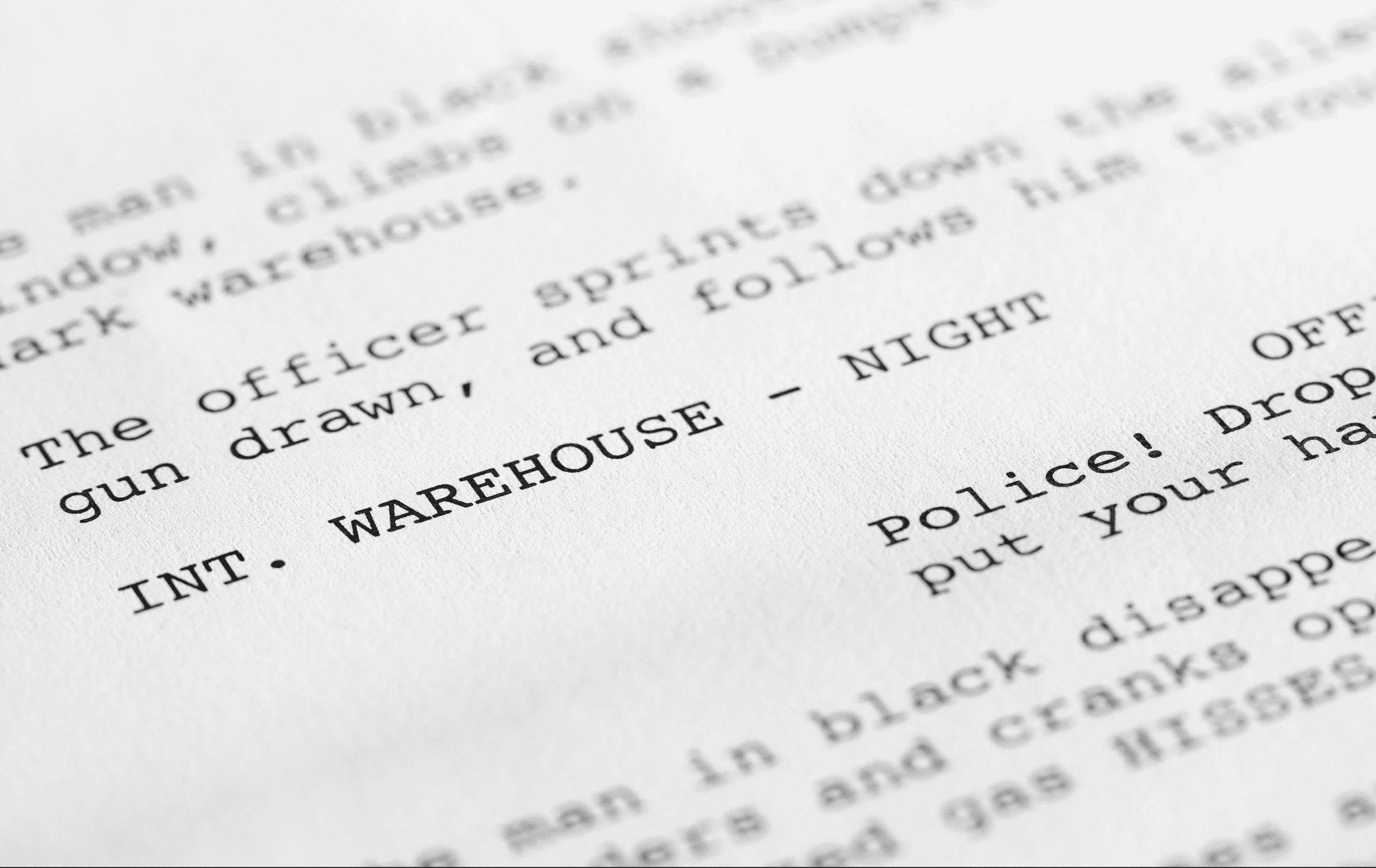
When you think of the word "screenplay", most will immediately think of dialogue.
But there are lots of moving parts around the dialogue.
A good screenplay is technical and easy to understand.
Page Numbers

Page numbers can be found in the upper right corner.
Page 1 does not start on the title page. But on the first page of action lines and dialogue.
Transitions
Transitions are used to indicate changes in time or location between scenes.
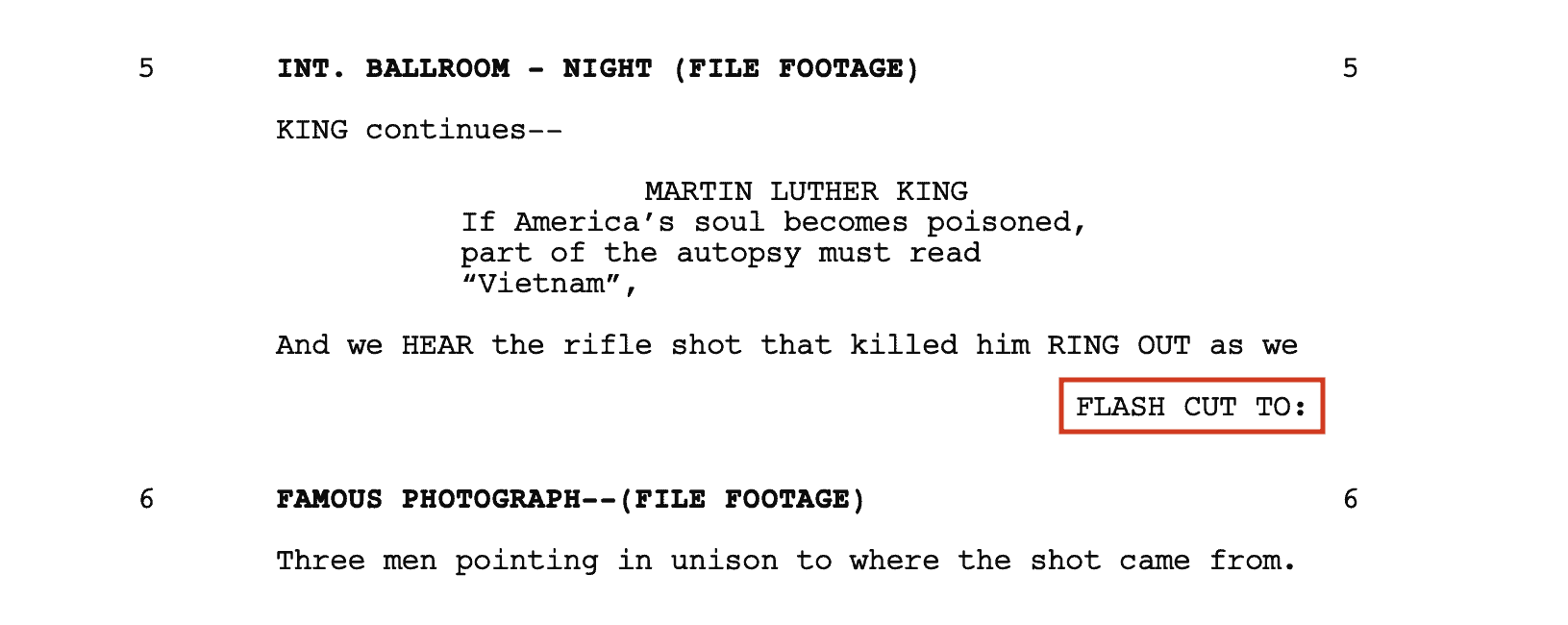
Common transition examples include: "CUT TO:", "FADE IN:", "FADE OUT:", "DISSOLVE TO:", etc.
Scene Numbers
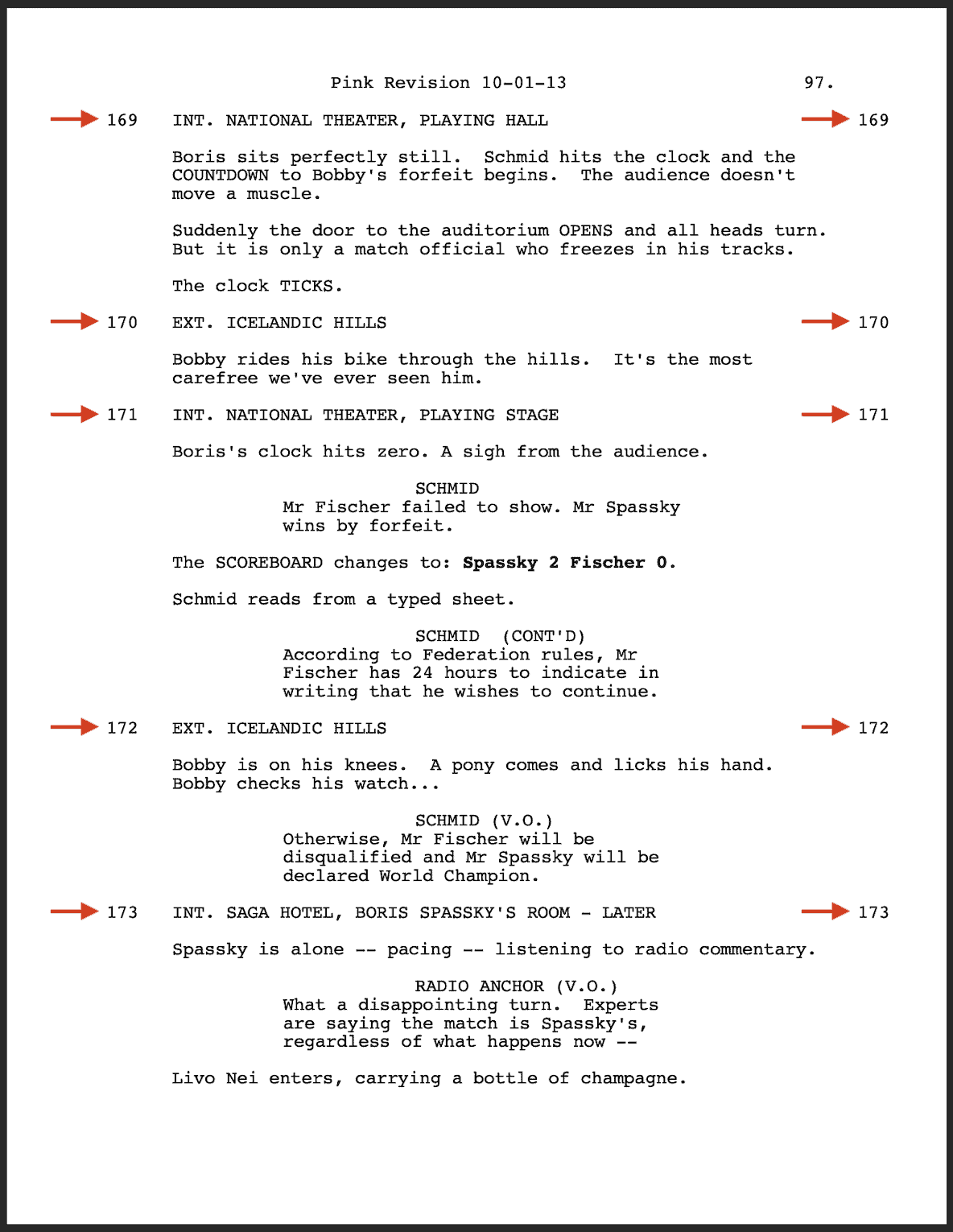
These can be found at the left and right of every new scene.
Scene Headings

Scene headings are used to indicate the beginning of a new scene.
Some in the industry may also refer to this as a "slug line".
There are three main parts to scene headings:
Interior or Exterior
Written as "INT." or "EXT." in a screenplay.
A single scene may have characters moving in and out of different locations. I've seen "INT./EXT." used in screenplay scenes such as these. This abbreviation can also be used for a scene in a car.
Why do we use abbreviations? It's faster to read.
Name Of Location
This can be as simple as "HOME" or as complicated as "PLANET SATURN - STEVEN'S SPACECRAFT - LOADING BAY - OFFICE".
A location name any longer than that is too much information.
Time Of Day
"NIGHT" or "DAY" are simple and easy to understand.
"DAWN" or "DUSK" will always give off particular color hues. And so the lighting crew needs to know that, for instance.
What if the scene takes place more than a day?
It's important to keep the scene present and within the confines of a day.
If a scene takes place over a week or month, the scene heading must change with each shot.
Examples Of Scene Headings
"EXT. - CAR DEALERSHIP - MORNING"
"INT. - AIRPORT - NIGHT"
Shot Descriptions

Shot descriptions are used when the screenwriter wants to convey the vision of the scene.
Inexperienced screenwriters often get carried away with shot descriptions, writing too much fluff.
The problem with fluff is that it can confuse the cast and crew.
Shot descriptions are optional in most cases and I only advise using them when necessary.
Shot descriptions should not mention how shots should be specifically executed. But rather, just a clear description of the shot.
Examples Of Shot Descriptions
"As the court report comes into frame, it reads 'Life in prison'."
"She is wearing lots of fancy jewelry, and a new pack of cigarettes is on her table."
"It's a scorching hot day and it isn't even noon yet."
Action Lines

Action lines describe the character movements of a scene, as well as the movement of visual elements or set pieces.
They help set the intended tone, mood, and pacing of the story.
It's important to remember that, outside of the dialogue, a screenplay is a technical document and should read like a car manual; in a "matter-of-fact" fashion.
Examples Of Action Lines
"Fred shuts his book and stares out the window as the rain pours down it."
"He takes a deep breath before walking into the crowded room again."
"The car turns left and stops in front of the barbershop."
Character Name

The dialogue should always be accompanied by the character's name at the top.
If dialogue runs off onto the next page, make sure to re-list the character's name at the top of the next page.
Parentheticals

Parentheticals provide specific instructions or information about how a character's dialogue should be delivered. These are brief notes enclosed in parentheses and are placed directly beneath the character's name in the script. They can clarify emotions, indicate actions, or suggest the direction of the character's line reading.
Like with shot descriptions, it's easy to overuse parentheticals. And should be used sparingly.
Dialogue

Dialogue is the verbal exchange between characters. It brings the characters to life, revealing their personality traits, emotions and motivations. Dialogue also serves to advance the plot, create conflict or resolve tension within the story.
What is Dual Dialogue?
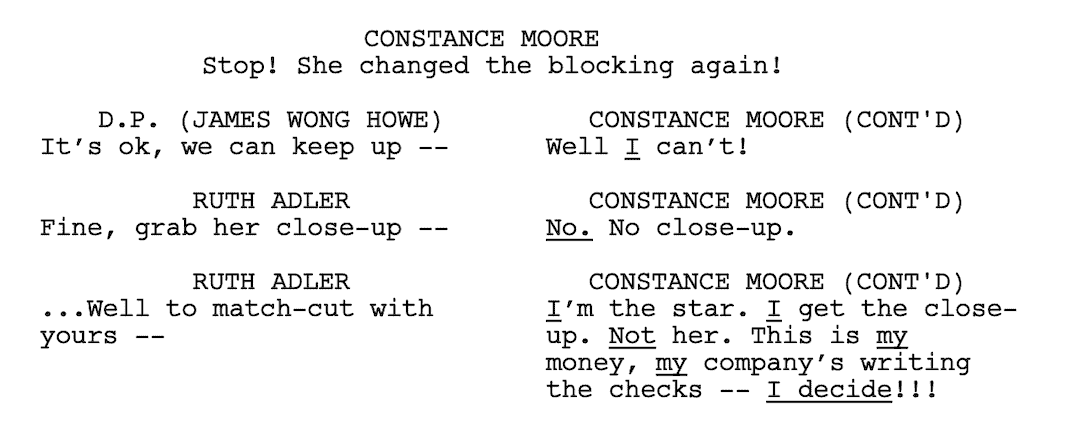
When two characters are speaking at the same time, it's written using a technique called dual dialogue. This formatting style splits the dialogue column into two, displaying two characters' dialogue side by side.
It's used sparingly, for moments of chaos or intense emotion where characters may speak over each other.
This indicates that both characters are speaking simultaneously. The parentheticals provide additional context for the characters' emotional states during their overlapping dialogue.
Act Breaks
Screenplays are often divided into acts, with each act representing a significant section of the story.
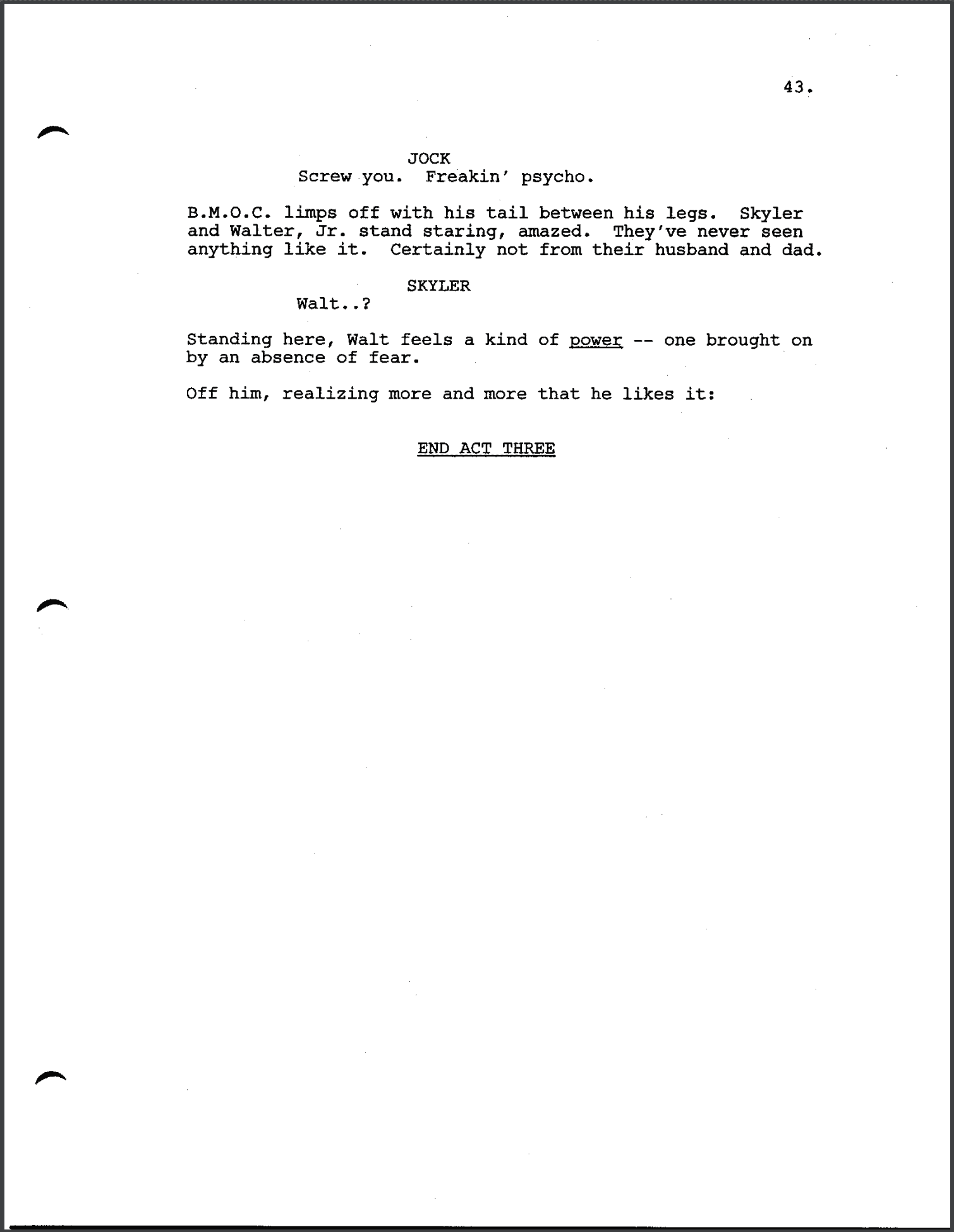
Act breaks are notated to indicate the end of one act and the beginning of another.
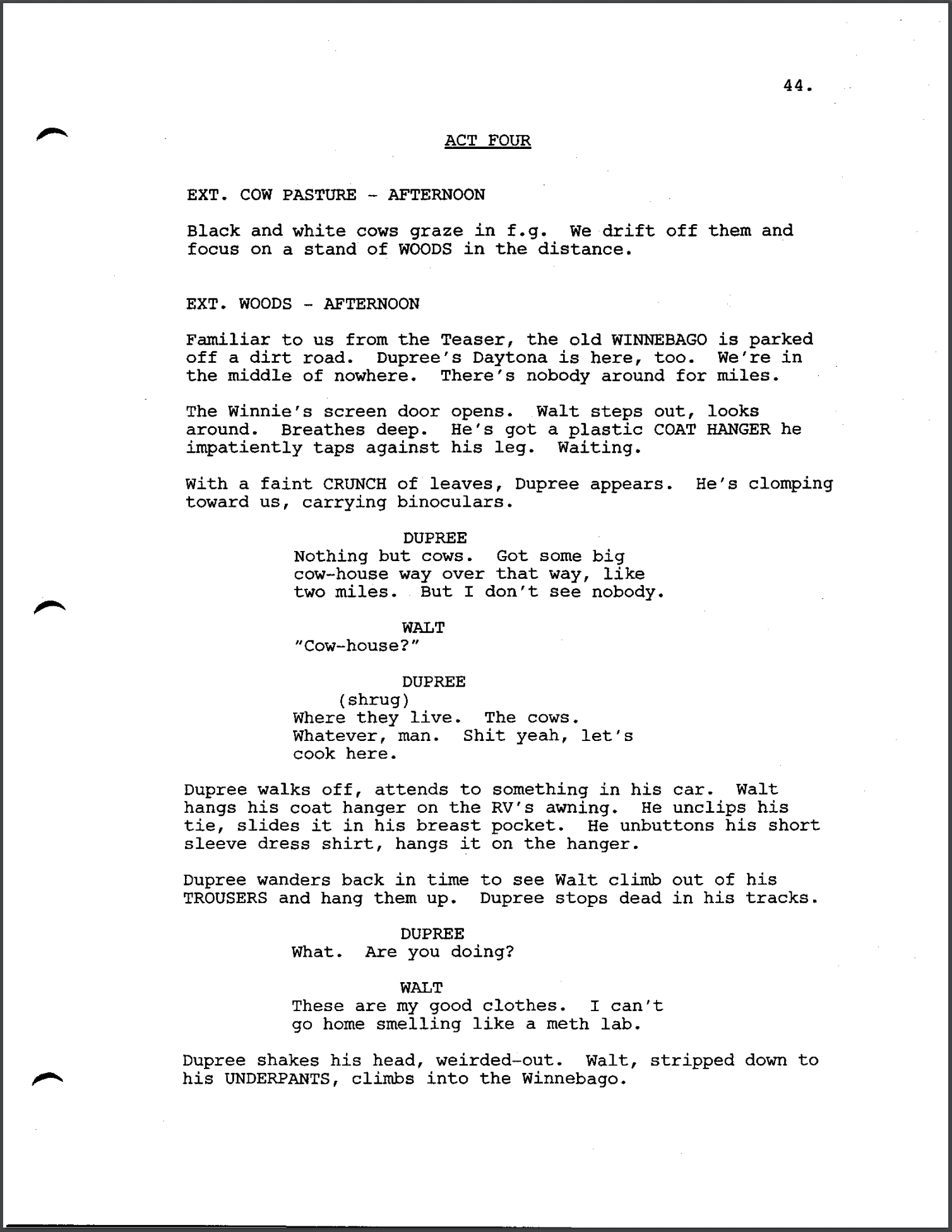
What Is The Best Screenwriting Software For Professionals?
Several screenwriting software platforms are favored by professionals.
Final Draft
Final Draft is often hailed as the industry standard. It offers a wide range of features such as script formatting in industry-standard layout, character and location navigation, and a revision mode.
Celtx
Celtx is another popular choice, offering robust features for scriptwriting, storyboarding, and production. Its cloud-based service allows for real-time collaboration, making it an excellent choice for teams.
Fade In
Fade In, while less known, has gained popularity for its user-friendly interface and affordability. It supports a range of file formats, includes a scene navigator, and offers a robust revision tracking feature.
How Many Pages Are In A Screenplay?
The total number of pages in a screenplay varies greatly depending on the medium and screenplay formatting.
A movie script is between 90 and 120 pages.
TV Series (Drama): One episode of an hour-long drama series is around 50 to 60 pages.
TV Series (Comedy): Half-hour comedy episodes usually range from 25 to 35 pages.
TV Shows (Variety, Talk Shows, etc.): The page count for these shows can vary widely depending on the content and format, but generally, they are shorter than drama or comedy scripts.
Commercials: Commercial scripts are usually very short and concise, often just a few pages or even a single page. They are designed to convey the message quickly within a short amount of screen time.
These are general guidelines, and actual page counts can fluctuate based on the writing style, dialogue length, and screenplay formatting of the writer or the specific requirements of the production company.
Some TV dramas may have longer scripts, and certain commercial scripts might be more extended if they have multiple variations or require specific details for production.
Ultimately, it comes down to ensuring that your story carries enough weight within the given page count limit and how quickly the story needs to move.
How Long Does It Take To Write A Screenplay?
The duration required to write a screenplay depends largely on the writer's experience, the complexity of the story, and the format of the screenplay.
Feature Films
Writing the screenplay for a feature film often takes about three to six months for a first draft, assuming the writer is working full time. This includes developing the story, creating characters and their arcs, and structuring the screenplay. If the writer can devote only a few hours a day, it could take a year or more.
Television
Writing TV scripts can be a bit quicker due to their shorter length. An experienced writer might complete a draft for a one-hour drama in a month, while a half-hour comedy could be completed in a couple of weeks.
Commercials
Commercial scripts, being the shortest, are usually completed in a few days to a week. These scripts require a concise, clear message that can be written and revised quickly.
It's important to factor in time for rewrites in all formats. Rewrites based on feedback from producers, directors, or actors can add weeks, or even months to the writing process.
These timelines are approximations. Each writer's process is unique, and the quality of the script should always take precedence over speed. Writing a screenplay is a creative process that can't be rushed, and taking the time to refine your story will lead to a better end product.
What Is A Spec Script?
A spec script, short for speculative screenplay, is a non-commissioned and unsolicited screenplay. It is a script written with the hope that it will be sold and eventually turned into a movie or television episode.
Spec scripts serve as a demonstration of a screenwriter's storytelling abilities and command over screenplay format. This is often how screenwriters break into the industry, as it allows them to showcase their unique voice and talent without the constraints of an existing commission or adaptation.
These scripts are often original works, but they can also be "spec episodes" written for existing television shows. These can demonstrate a writer's ability to adapt to established characters and storylines.
However, whether original or an adaptation, the success of a spec script largely depends on its ability to engage and entertain the script readers, as it must stand out among a sea of other speculative screenplays.
What Is An Adapted Screenplay?
An adapted screenplay is a script that has been derived from an existing piece of work. This source material could be a book, a play, a movie, a TV show, or even real-life events.
In terms of format, it does not differ significantly from an original screenplay, but it requires the screenwriter to reshape the narrative to suit the cinematic medium. This may involve altering plot lines, condensing timelines, and modifying characters to create a story that works visually and maintains audience engagement.
Success in adapted screenplays lies not merely in replicating the original, but in creatively interpreting it for the screen while retaining its essence.
What Is A Shooting Script?
A shooting script is the final version of a screenplay that is used during the production of a film or television episode. This script includes technical instructions necessary for shooting, such as camera angles, shot types, and editing notes.
Unlike standard screenplays that primarily serve the narrative, shooting scripts cater to the practical aspects of making a film. While it still contains dialogue and scene descriptions, it is annotated with specific directives for the director, cinematographer, and other crew members.
This type of script is a crucial tool in visual storytelling and serves as the blueprint for the entire production crew.
What Is A Two-Column Script?
A Two-Column Script, also known as an AV (Audio-Visual) script, is a format predominantly used in television production, documentaries, corporate videos, and commercials. As implied by the name, it uses a two-column format where the left column details the visual elements ("Video") and the right column contains the corresponding audio information ("Audio"). The "Video" column typically includes descriptions of the scenes, actions, and visuals, while the "Audio" column includes dialogue, voice-over, music, and sound effects.
This script format allows for a clear simultaneous representation of the visual and audio aspects of production, facilitating a concrete understanding of how the final product will look and sound.
What Are Storyboards?

Storyboards are essentially graphic organizers that delineate the sequence of a story or visuals for films, TV shows, animation, or even a commercial. Originating from the world of animation, with Walt Disney Studios being a pioneer, storyboarding is now an integral part of various media and creative industries. They serve as a visual blueprint, outlining the scenes of the narrative, the character's actions and dialogue, and even camera angles in a series of sketches or illustrations.
Each panel of a storyboard represents a specific segment of the narrative, complete with accompanying notes for dialogue, sound effects, and other relevant details. This format provides a clear, tangible connection between the script and the visual representation. It's an invaluable tool that enables crew members to visualize the storytelling, plan the shots, and discuss and resolve potential issues before actual production begins.
Conclusion

Writing and formatting a screenplay requires an in-depth understanding of the structure.
What is a screenplay without a proper screenplay format? The screenplay definition entails organizing a whole story into an understandable written work. So be sure to always have correct formatting.
Screenplays should be as concise as possible yet detailed enough to convey the intended story.
By following the guidelines and formatting rules outlined here, you can ensure that your finished script adheres to the established industry standards.
So let me ask, what is a screenplay to you?
